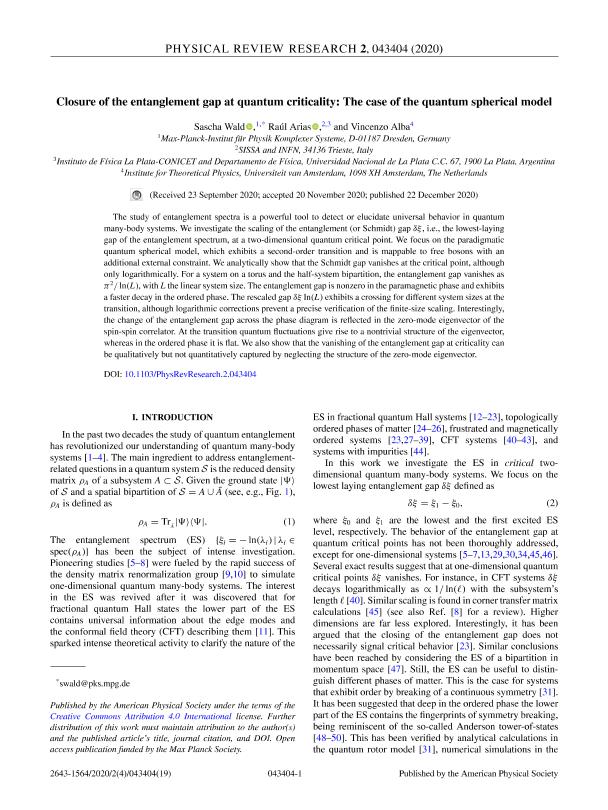Mostrar el registro sencillo del ítem
dc.contributor.author
Wald, Sascha
dc.contributor.author
Arias, Raúl Eduardo

dc.contributor.author
Alba, Vincenzo
dc.date.available
2021-10-28T18:44:23Z
dc.date.issued
2020-12
dc.identifier.citation
Wald, Sascha; Arias, Raúl Eduardo; Alba, Vincenzo; Closure of the entanglement gap at quantum criticality: The case of the quantum spherical model; American Physical Society; Physical Review Research; 2; 043404; 12-2020; 1-19
dc.identifier.issn
2643-1564
dc.identifier.uri
http://hdl.handle.net/11336/145397
dc.description.abstract
The study of entanglement spectra is a powerful tool to detect or elucidate universal behavior in quantum many-body systems. We investigate the scaling of the entanglement (or Schmidt) gap δξ , i.e., the lowest-laying gap of the entanglement spectrum, at a two-dimensional quantum critical point. We focus on the paradigmatic quantum spherical model, which exhibits a second-order transition and is mappable to free bosons with an additional external constraint. We analytically show that the Schmidt gap vanishes at the critical point, although only logarithmically. For a system on a torus and the half-system bipartition, the entanglement gap vanishes as π2/ ln(L), with L the linear system size. The entanglement gap is nonzero in the paramagnetic phase and exhibits a faster decay in the ordered phase. The rescaled gap δξ ln(L) exhibits a crossing for different system sizes at the transition, although logarithmic corrections prevent a precise verification of the finite-size scaling. Interestingly, the change of the entanglement gap across the phase diagram is reflected in the zero-mode eigenvector of the spin-spin correlator. At the transition quantum fluctuations give rise to a nontrivial structure of the eigenvector, whereas in the ordered phase it is flat. We also show that the vanishing of the entanglement gap at criticality can be qualitatively but not quantitatively captured by neglecting the structure of the zero-mode eigenvector.
dc.format
application/pdf
dc.language.iso
eng
dc.publisher
American Physical Society

dc.rights
info:eu-repo/semantics/openAccess
dc.rights.uri
https://creativecommons.org/licenses/by-nc-sa/2.5/ar/
dc.subject
ENTANGLEMENT SPECTRUM
dc.subject
QUANTUM ENTANGLEMENT
dc.subject
QUANTUM PHASE TRANSITIONS
dc.subject
QUANTUM STATISTICAL MECHANICS
dc.subject.classification
Física de los Materiales Condensados

dc.subject.classification
Ciencias Físicas

dc.subject.classification
CIENCIAS NATURALES Y EXACTAS

dc.title
Closure of the entanglement gap at quantum criticality: The case of the quantum spherical model
dc.type
info:eu-repo/semantics/article
dc.type
info:ar-repo/semantics/artículo
dc.type
info:eu-repo/semantics/publishedVersion
dc.date.updated
2021-09-06T17:45:28Z
dc.identifier.eissn
2643-1564
dc.journal.volume
2
dc.journal.number
043404
dc.journal.pagination
1-19
dc.journal.pais
Estados Unidos

dc.description.fil
Fil: Wald, Sascha. Max-planck-institut Für Physik Komplexer Systeme; Alemania
dc.description.fil
Fil: Arias, Raúl Eduardo. Consejo Nacional de Investigaciones Científicas y Técnicas. Centro Científico Tecnológico Conicet - La Plata. Instituto de Física La Plata. Universidad Nacional de La Plata. Facultad de Ciencias Exactas. Instituto de Física La Plata; Argentina. Scuola Internazionale Superiore di Studi Avanzati; Italia
dc.description.fil
Fil: Alba, Vincenzo. University of Amsterdam; Países Bajos
dc.journal.title
Physical Review Research
dc.relation.alternativeid
info:eu-repo/semantics/altIdentifier/url/https://link.aps.org/doi/10.1103/PhysRevResearch.2.043404
dc.relation.alternativeid
info:eu-repo/semantics/altIdentifier/doi/http://dx.doi.org/10.1103/PhysRevResearch.2.043404
Archivos asociados
